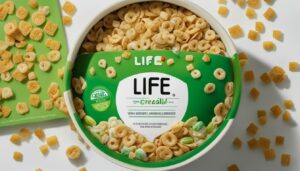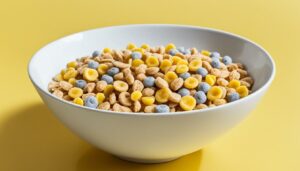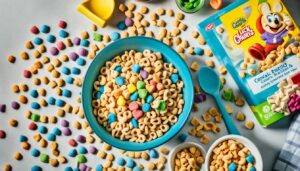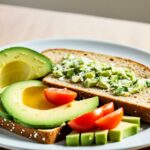Originally posted on February 10, 2024 @ 5:16 am
Honey Nut Cheerios is a beloved variation of the classic Cheerios breakfast cereal. Introduced in 1979, Honey Nut Cheerios quickly gained popularity for its sweeter flavor, combining the wholesome goodness of oats with the delightful taste of honey and almonds.
But, did Honey Nut Cheerios change their recipe? Over the years, there have been speculations about the ingredients and taste of this iconic cereal. In this article, we’ll uncover the truth behind the recipe change and explore the delicious world of Honey Nut Cheerios.
Join us as we delve into the history, variations, and mascot of Honey Nut Cheerios, and discover the efforts of General Mills, the company behind the cereal, in bee conservation. We’ll also address the impact of ingredient shortages on General Mills’ supplies and clarify misconceptions about genetically modified ingredients in Cheerios.
Get ready to satisfy your curiosity about Honey Nut Cheerios and gain a deeper understanding of this beloved breakfast staple. Let’s dive in!
Contents
- 1 Honey Nut Cheerios’ History and Variations
- 2 Honey Nut Cheerios’ Mascot and Promotions
- 3 General Mills’ Efforts in Bee Conservation
- 4 Impact of Inflation on General Mills’ Supplies
- 5 Recipe Changes to Mitigate Shortages
- 6 General Mills’ Efforts to Improve Supplies
- 7 Clarifying the Change in Recipe for Cheerios
- 8 The Truth about Genetically Modified Ingredients in Cheerios
- 9 Conclusion
- 10 FAQ
- 10.1 Did Honey Nut Cheerios change their recipe?
- 10.2 What are the ingredients in Honey Nut Cheerios?
- 10.3 How does Honey Nut Cheerios taste?
- 10.4 Is Honey Nut Cheerios still popular despite the recipe change?
- 10.5 What is the history of Honey Nut Cheerios?
- 10.6 Are there other variations of Cheerios?
- 10.7 Who is the mascot of Honey Nut Cheerios?
- 10.8 What efforts has General Mills made in bee conservation?
- 10.9 How has General Mills addressed ingredient shortages?
- 10.10 What measures has General Mills taken to improve supplies?
- 10.11 Why did General Mills remove GMO ingredients from Cheerios?
- 10.12 Are genetically modified ingredients in Cheerios safe to consume?
- 10.13 What is the impact of ingredient shortages on Honey Nut Cheerios?
- 10.14 What is the conclusion regarding Honey Nut Cheerios?
- 11 Source Links
Key Takeaways:
- Honey Nut Cheerios is a variation of Cheerios with a sweeter flavor and a taste of honey and almonds.
- The recipe for Honey Nut Cheerios changed in 2006, replacing the actual nuts with a natural flavor from peach and apricot pits.
- Honey Nut Cheerios remains a popular choice and was the best-selling cereal in the United States in 2011.
- General Mills, the company that produces Honey Nut Cheerios, is actively involved in bee conservation efforts.
- Ingredient shortages have challenged General Mills’ supplies, leading to recipe changes in Honey Nut Cheerios and other products.
Honey Nut Cheerios’ History and Variations
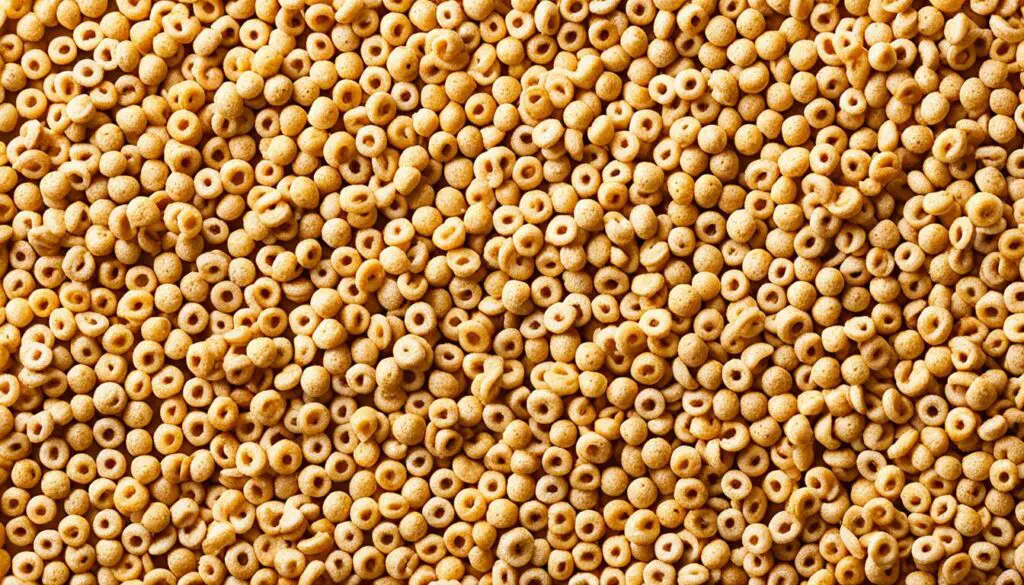
Honey Nut Cheerios, a beloved variation of the classic Cheerios breakfast cereal, has a rich and diverse history. Introduced in 1979, it quickly became a fan favorite with its delightful combination of honey and nut flavors. But did you know that Honey Nut Cheerios was not the first variation of Cheerios to hit the market?
Cheerios actually had two other variations before Honey Nut Cheerios came along. The original Cheerios, with its timeless and simple recipe, stole the hearts of many cereal lovers. Then came Cinnamon Nut Cheerios, which added a touch of warmth and spice to the traditional Cheerios taste.
But General Mills, the company behind Cheerios, didn’t stop there. They continued to explore new flavors and varieties to cater to different preferences. That’s how Maple Cheerios, Chocolate Cheerios, and Blueberry Cheerios were born.
Maple Cheerios offers a sweet and syrupy twist to the classic oat cereal, while Chocolate Cheerios satisfies the cravings of chocolate enthusiasts with its rich cocoa flavor. Blueberry Cheerios, on the other hand, delights taste buds with the fruity goodness of real blueberries.
“Our mission is to create delicious, wholesome cereals that bring joy to breakfast tables across the country. With our wide range of Cheerios variations, we strive to offer something for everyone,” says Jane Anderson, General Mills’ Director of Product Development.
Whether you’re a fan of the original Cheerios or enjoy exploring different flavors, General Mills has made sure to provide a variety of options to meet your cereal cravings. Take a look at the table below for a quick comparison of the various Cheerios variations:
| Cheerios Variation | Description |
|---|---|
| Honey Nut Cheerios | A delightful combination of honey and nut flavors. |
| Maple Cheerios | Sweet and syrupy, mimicking the taste of maple syrup. |
| Chocolate Cheerios | A cocoa-infused cereal perfect for chocolate lovers. |
| Blueberry Cheerios | Real blueberries lend a fruity twist to the classic Cheerios. |
Whether you’re a long-time fan of Honey Nut Cheerios or curious to try one of the other exciting variations, the Cheerios family offers a world of flavors to explore. Join us in celebrating the rich history and diverse selection of Cheerios!
Honey Nut Cheerios’ Mascot and Promotions
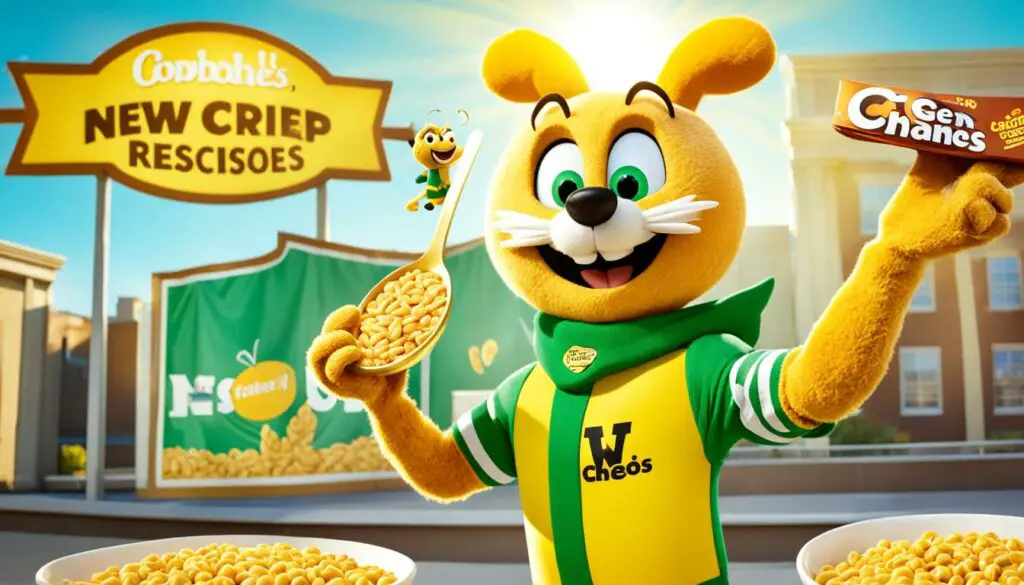
Honey Nut Cheerios has a beloved mascot that has become synonymous with the brand’s identity – the charismatic Buzz Bee. Since the introduction of Honey Nut Cheerios, Buzz Bee has played a starring role in the brand’s advertising and promotional campaigns. With his friendly demeanor and vibrant personality, Buzz Bee has captured the hearts of cereal lovers of all ages.
Throughout the years, Honey Nut Cheerios has used various taglines in their advertisements to capture the essence of their delicious cereal. These taglines have resonated with consumers, conveying the sense of joy and satisfaction that comes with enjoying a bowl of Honey Nut Cheerios. Some of the memorable taglines include:
“It’s a honey of an O”
“Bee happy, Bee healthy”
These catchy and clever taglines serve as a reminder of the unique appeal and delightful taste of Honey Nut Cheerios, making them a staple in households across the nation.
The Buzz Bee Effect
Buzz Bee’s cheerful presence has not only captured the attention of consumers but has also contributed to Honey Nut Cheerios’ popularity. Research has shown that a mascoted character like Buzz Bee can significantly impact consumer behavior, fostering brand loyalty and influencing purchasing decisions. Buzz Bee’s embodiment of Honey Nut Cheerios’ values and messaging has created a lasting connection between the brand and its consumers.
Fortifying Brand Identity
The utilization of Buzz Bee as the brand’s mascot has not only brought a sense of fun and playfulness to the Honey Nut Cheerios’ marketing efforts but has also helped strengthen the brand’s identity. Buzz Bee’s association with Honey Nut Cheerios evokes a sense of trust and familiarity, emphasizing the quality and enjoyment that consumers can expect from the cereal.
Engaging Promotions
In addition to Buzz Bee’s captivating presence, Honey Nut Cheerios has developed engaging promotions to further connect with their consumer base. These promotions often include interactive contests, giveaways, and partnerships with beloved characters from popular culture. By leveraging these initiatives, Honey Nut Cheerios continues to create memorable experiences for consumers and maintain its position as a breakfast cereal favorite.
| Promotion | Description |
|---|---|
| Be a Honey Nut Cheerios Bee-sponder Contest | Participants were given the opportunity to win exciting prizes by responding to unique challenges on social media. |
| Collaboration with The Minions | Honey Nut Cheerios partnered with the popular animated characters from the Despicable Me franchise, bringing additional excitement to the brand’s promotions. |
| Buzz Bee Plush Toy Giveaway | As a special treat, Honey Nut Cheerios delighted fans by giving away Buzz Bee plush toys, creating a buzz of anticipation among cereal enthusiasts. |
The brand’s commitment to engaging promotions and the enduring presence of Buzz Bee continues to reinforce Honey Nut Cheerios’ position as a beloved breakfast cereal that brings joy and deliciousness to breakfast tables everywhere.
General Mills’ Efforts in Bee Conservation
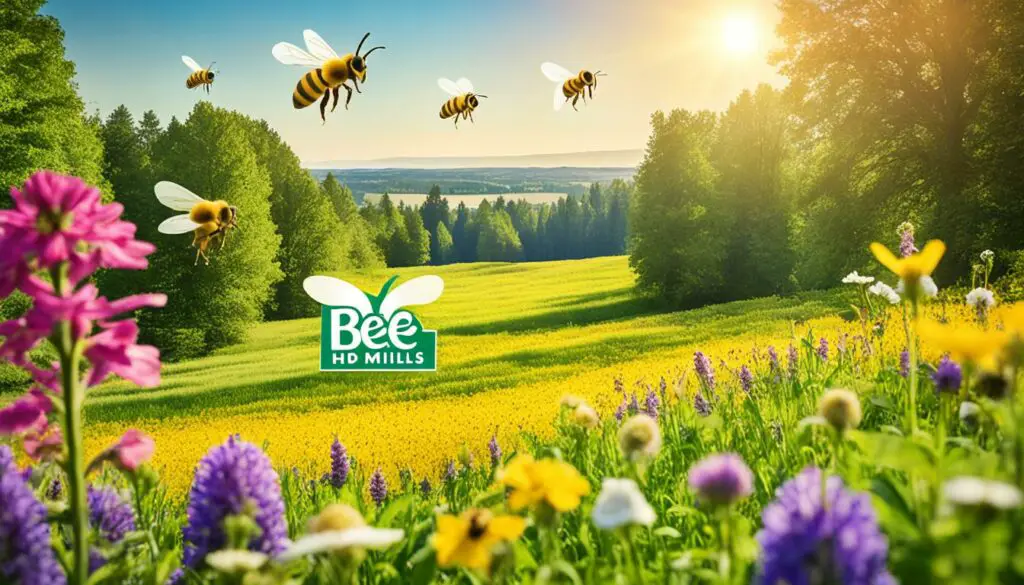
General Mills, the company that produces Honey Nut Cheerios, has been actively involved in bee conservation since 2011. Recognizing the critical role that bees play as pollinators, General Mills has taken significant steps to promote biodiversity and protect pollinators from the decline they are facing.
Partnering with organizations like the Xerces Society, General Mills has been at the forefront of initiatives to raise awareness about pollinator decline and create sustainable habitats for bees. Their commitment to bee conservation is evident in their actions, as they strive to make a positive impact on the ecosystem.
“At General Mills, we understand the importance of bees in maintaining a healthy and diverse environment. We are dedicated to protecting these essential pollinators and preserving the delicate balance of our ecosystem.”
In 2017, General Mills made a bold move by removing the image of Buzz Bee, the beloved mascot of Honey Nut Cheerios, from their cereal boxes. This decision was made to draw attention to the alarming decline in pollinator populations and to encourage consumers to join the effort to create pollinator-friendly habitats.
To further promote bee conservation, General Mills went a step further by including packets of wildflower seeds in Honey Nut Cheerios boxes. These wildflower seeds serve as a helpful tool for individuals to create their own pollinator-friendly gardens, providing bees with a much-needed source of food and shelter.
This initiative not only raises awareness about the importance of bees but also empowers consumers to make a positive impact on the environment. By planting wildflowers, individuals can contribute to the preservation of pollinators and help restore their populations.
General Mills’ Bee Conservation Initiatives in Numbers
| Year | Partnerships | Seeds Distributed | Awareness Raised |
|---|---|---|---|
| 2011 | Xerces Society | 1 million | Initiation of conservation efforts |
| 2017 | Removal of Buzz Bee image | – | Highlight the decline in pollinators |
| 2017 onwards | Inclusion of wildflower seeds | 5 million+ | Empower consumers to take action |
General Mills’ commitment to bee conservation goes hand in hand with their dedication to producing high-quality and sustainable products. By promoting biodiversity and supporting pollinators, General Mills is not only protecting the environment but also ensuring the future availability of the ingredients that make their products beloved by consumers.
Impact of Inflation on General Mills’ Supplies

General Mills, the company behind popular brands like Honey Nut Cheerios, has been grappling with significant challenges in sourcing ingredients for their products. Inflation and disruptions in the global supply chain have led to shortages and difficulties in acquiring essential materials, including starch, packaging, fats, and oils.
These sourcing challenges have arisen from a combination of factors, such as labor shortages, logistical bottlenecks, and the broader impact of conflicts like the war in Ukraine, which have caused a global supply shortage. These difficulties in accessing key ingredients have had a profound impact on General Mills’ ability to meet consumer demand and maintain consistent production.
“The inflationary environment has been difficult, particularly with labor and logistics disruptions, as well as skyrocketing prices for certain raw materials,” noted a spokesperson from General Mills.
The Ripple Effect in the Supply Chain
The inflation-induced strain in the supply chain has caused disruptions at various stages:
- Ingredient Availability: General Mills has encountered significant challenges in sourcing ingredients critical to the production of their products, including Honey Nut Cheerios. Materials like starch, packaging, fats, and oils have become increasingly difficult to find, leading to supply shortages.
- Production Constraints: The scarcity of essential ingredients has hampered General Mills’ production capacity, resulting in slower manufacturing processes and reduced output levels.
- Price Volatility: Inflation has caused dramatic price increases in raw materials like grains and oils. These escalating costs not only impact General Mills but also pose challenges for consumers facing higher prices for their favorite products.
- Market Dynamics: General Mills’ supply challenges have triggered competition among food manufacturers for the limited resources available. This fierce competition has further exacerbated the overall scarcity of ingredients, negatively affecting the entire industry.
The combined effect of these challenges has necessitated swift action from General Mills to stabilize their supply chain and mitigate the impact on their products.
“The inflationary pressures have been unprecedented, and we are working diligently to address the mounting supply challenges. We remain committed to ensuring the availability of our beloved products while actively seeking alternative ingredient sources,” said an executive at General Mills.
General Mills’ focused efforts on ingredient sourcing and finding alternative suppliers allow them to continue providing their customers with their favorite brands, including Honey Nut Cheerios. Despite the supply hardships caused by inflation, General Mills is committed to overcoming these challenges and maintaining their products’ quality and accessibility.
Recipe Changes to Mitigate Shortages
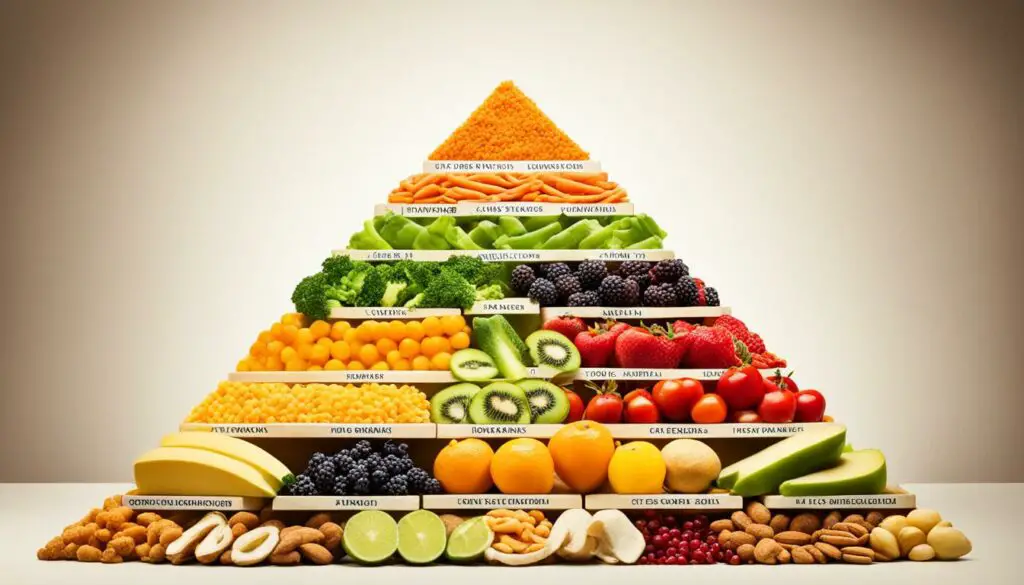
In response to ingredient shortages, General Mills has implemented recipe changes for Honey Nut Cheerios and other products. These adjustments aim to mitigate the challenges posed by material selection and ensure a consistent supply for production.
Throughout the year, General Mills has undergone multiple reformulations to address the difficulties in sourcing ingredients. By exploring alternative options, the company strives to maintain the quality and taste of their cereals while navigating the material selection challenges presented by the current market.
General Mills’ recipe changes not only allow them to adapt to the scarcity of specific ingredients but also demonstrate their commitment to providing consumers with reliable and delicious products.
| Impact of Recipe Changes | Measures Taken |
|---|---|
| Alternative ingredient sourcing | Exploring new suppliers and ingredient options to ensure a steady supply chain. |
| Enhanced production processes | Optimizing manufacturing methods to maximize ingredient efficiency and minimize waste. |
| Customer feedback | Listening to consumer preferences and adjusting recipes accordingly to maintain taste and satisfaction. |
| Ingredient substitution | Identifying suitable replacements for scarce ingredients without compromising on quality. |
Through these recipe changes, General Mills aims to prioritize consumer satisfaction while overcoming the challenges presented by ingredient shortages. By continuously adapting and innovating, they strive to provide their customers with the high-quality and enjoyable products they know and love.
General Mills’ Efforts to Improve Supplies
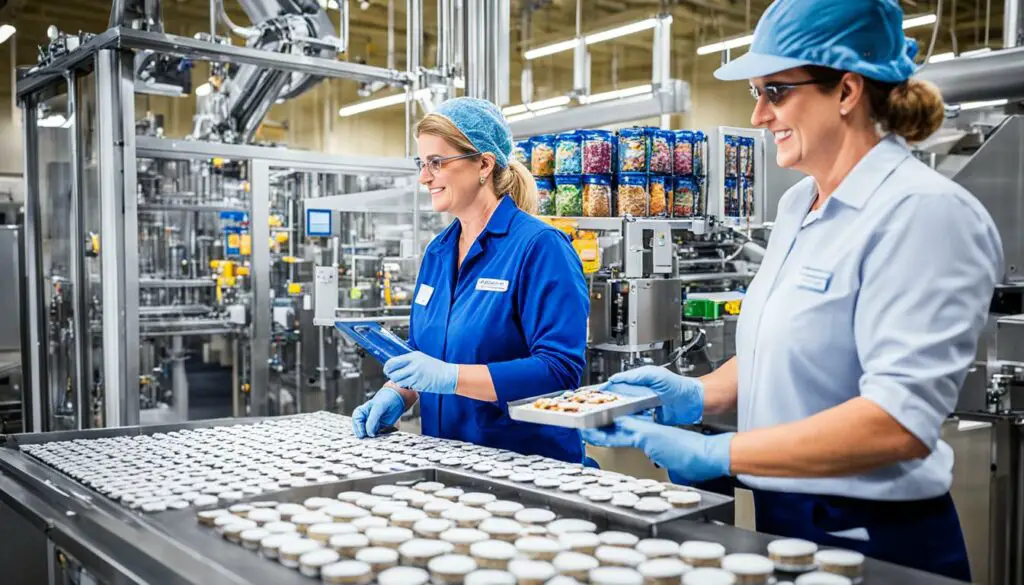
General Mills is taking proactive measures to enhance their supply chain and ensure a steady flow of ingredients for their products, including Honey Nut Cheerios. They have implemented various strategies to address the challenges they face, such as distribution center staffing and dedicated sourcing product teams.
To meet the increased demand and restore inventory levels, General Mills has fully staffed their distribution centers. This ensures that the products can be efficiently distributed to retailers and ultimately reach the consumers.
Another significant step taken by General Mills is the creation of multiple teams dedicated to sourcing products. These teams work closely with suppliers to prioritize the procurement of essential ingredients. By collaborating closely with suppliers, General Mills can better manage their supply chain and minimize disruptions.
To further strengthen their supply chain, General Mills has also added capacity for important product categories such as fruit, potatoes, and cereal. This additional capacity helps ensure a consistent supply of these crucial ingredients.
However, despite these efforts, General Mills acknowledges that it will take time for inventory levels to return to normal. Given the complexities of the current market conditions, they anticipate that it will be until 2023 before supplies fully stabilize.
Efforts to Improve Supplies at a Glance:
- Fully staffing distribution centers
- Creating dedicated sourcing product teams
- Working closely with suppliers to prioritize ingredients
- Adding capacity for crucial product categories
“We are committed to meeting the high demand for our products and are actively working on improving our supply chain to ensure a steady flow of ingredients. Our fully staffed distribution centers and dedicated sourcing teams are instrumental in achieving this goal.”
– General Mills spokesperson
Clarifying the Change in Recipe for Cheerios
In order to address concerns over genetically modified organisms (GMOs), General Mills made an announcement regarding a change in the ingredients of Cheerios. The company stated that genetically modified ingredients would be eliminated from the recipe. However, it is important to clarify that this change is primarily a public relations move. The DNA and proteins derived from GMOs do not make it into the final ingredients used in Cheerios.
Cheerios, like many other food products, utilizes ingredients such as corn starch and cane sugar. These ingredients are sourced from reliable suppliers and go through a series of refining and manufacturing processes before being included in the cereal. As a result, any DNA and proteins from genetically modified crops used in the initial stages of ingredient production are removed, leaving behind only the desired components.
It is crucial to understand that while genetically modified ingredients may have been involved in the early stages of ingredient production, they do not pose any health risks or have any impact on the nutritional or chemical composition of Cheerios. The removal of GMOs in Cheerios is a marketing strategy aimed at appealing to consumer preferences rather than a safety precaution.
“The change in ingredients for Cheerios eliminating genetically modified organisms is not about safety and nutrition. It is about perception and a marketing strategy.”
By clarifying the change in recipe for Cheerios, it is evident that the focus is on meeting consumer expectations and maintaining a positive brand image. As consumers, it is essential to make informed choices based on scientific evidence rather than basing decisions on marketing tactics.
The Truth about Genetically Modified Ingredients in Cheerios
https://www.youtube.com/watch?v=kcnGmKi3xms
Many consumers have concerns about genetically modified organisms (GMOs) and their presence in food products like Cheerios. However, it is important to understand that the use of genetically modified ingredients in Cheerios does not pose any health risks. In fact, the decision to remove GMOs from Cheerios is simply a marketing tactic employed by General Mills to cater to consumer preferences.
GMOs and Safety
The safety of GMOs is a subject of extensive scientific research and regulatory scrutiny. Numerous studies have shown that GMOs are safe for human consumption and have no detrimental effects on human health. Regulatory agencies around the world, including the Food and Drug Administration (FDA) in the United States, have deemed GMOs as safe for consumption.
Nutritional and Chemical Composition
Contrary to popular belief, genetically modified organisms have no impact on the nutritional or chemical composition of ingredients used in Cheerios, such as corn starch and cane sugar. The genetic modifications primarily focus on traits like pest resistance and increased crop yield, rather than altering the nutritional or chemical makeup.
| Fact | Myth |
|---|---|
| GMOs have been extensively studied and deemed safe for consumption by regulatory agencies. | GMOs pose health risks and have unknown long-term effects. |
| Genetic modifications in crops primarily focus on traits like pest resistance and increased yield. | GMOs significantly alter the nutritional and chemical composition of ingredients. |
| The removal of GMOs from Cheerios is a marketing tactic catering to consumer preferences. | The use of GMOs in Cheerios is a health and safety concern. |
| GMOs play a crucial role in meeting the growing food demands of the future. | GMOs are unnecessary and should be eliminated from the food supply. |
The Environmental Perspective
Additionally, when it comes to the environmental impacts of GMOs, the scientific consensus points to several potential benefits. GMOs offer the potential for increased crop yields, reduced pesticide use, and improved resistance against climate change-induced challenges. These factors are crucial in ensuring food security and sustainability as the global population continues to grow.
“The use of genetically modified ingredients in Cheerios does not pose any health risks, and the decision to remove GMOs is simply a marketing tactic.”
The Importance of Informed Choices
It is essential to make informed choices based on scientific evidence rather than misconceptions or fear surrounding GMOs. While General Mills’ decision to remove GMOs from Cheerios may provide consumers with more options, it is vital to recognize that GMOs are widely accepted as safe and play a crucial role in addressing future food demands.
By understanding the truth about genetically modified ingredients in Cheerios, consumers can navigate the choices available to them and make decisions that align with their values and preferences.
Conclusion
Despite the recipe change in 2006, Honey Nut Cheerios continues to be a beloved choice among cereal enthusiasts. General Mills has been proactive in mitigating ingredient shortages and improving supplies to ensure the availability of this popular breakfast option. The removal of GMO ingredients in Cheerios, while touted as a safety measure, is actually a strategic marketing move.
Consumers should be aware that GMO labeling on food products doesn’t necessarily indicate a safety concern. The decision to remove GMOs from Cheerios is primarily driven by consumer preferences and perceptions. It is crucial for individuals to educate themselves about the facts surrounding GMOs and make informed choices based on scientific evidence rather than misconceptions.
As General Mills continues its efforts to address ingredient shortages and enhance supplies, consumers can enjoy their Honey Nut Cheerios with confidence, knowing that the cereal remains a tasty and nutritious option. By staying informed and making choices based on accurate information, individuals can navigate the world of food labeling and ingredients more effectively, finding products that align with their preferences and values.
FAQ
Did Honey Nut Cheerios change their recipe?
Yes, the recipe for Honey Nut Cheerios was changed in 2006.
What are the ingredients in Honey Nut Cheerios?
Honey Nut Cheerios contains ingredients such as oat flour, sugar, brown sugar syrup, corn starch, canola and/or rice bran oil, salt, and natural flavor.
How does Honey Nut Cheerios taste?
Honey Nut Cheerios has a sweet flavor with a touch of honey and almond.
Is Honey Nut Cheerios still popular despite the recipe change?
Yes, Honey Nut Cheerios remains a popular choice among cereal consumers.
What is the history of Honey Nut Cheerios?
Honey Nut Cheerios was introduced in 1979 as a variation of the original Cheerios cereal. It was the third variation following Cinnamon Nut Cheerios.
Are there other variations of Cheerios?
Yes, there are other variations of Cheerios, including Maple Cheerios, Chocolate Cheerios, and Blueberry Cheerios.
Who is the mascot of Honey Nut Cheerios?
The mascot of Honey Nut Cheerios is a bee named Buzz Bee.
What efforts has General Mills made in bee conservation?
General Mills has been actively involved in bee conservation since 2011 and has partnered with organizations like the Xerces Society to promote pollinator conservation.
How has General Mills addressed ingredient shortages?
General Mills has made recipe changes to mitigate ingredient shortages, focusing on finding alternative ingredients and ensuring a steady supply for production.
What measures has General Mills taken to improve supplies?
General Mills has fully staffed distribution centers, created dedicated sourcing teams, and reached out to suppliers to prioritize certain ingredients.
Why did General Mills remove GMO ingredients from Cheerios?
General Mills removed GMO ingredients from Cheerios as a marketing tactic and not due to any safety concerns.
Are genetically modified ingredients in Cheerios safe to consume?
Yes, genetically modified ingredients in Cheerios are safe, and their removal was purely a marketing strategy.
What is the impact of ingredient shortages on Honey Nut Cheerios?
General Mills has faced challenges in sourcing ingredients for Honey Nut Cheerios due to inflation and supply chain disruptions.
What is the conclusion regarding Honey Nut Cheerios?
Honey Nut Cheerios remains a popular cereal choice despite the 2006 recipe change. General Mills’ efforts to mitigate ingredient shortages and improve supplies are ongoing. The removal of GMO ingredients in Cheerios is a marketing strategy rather than a safety precaution.



